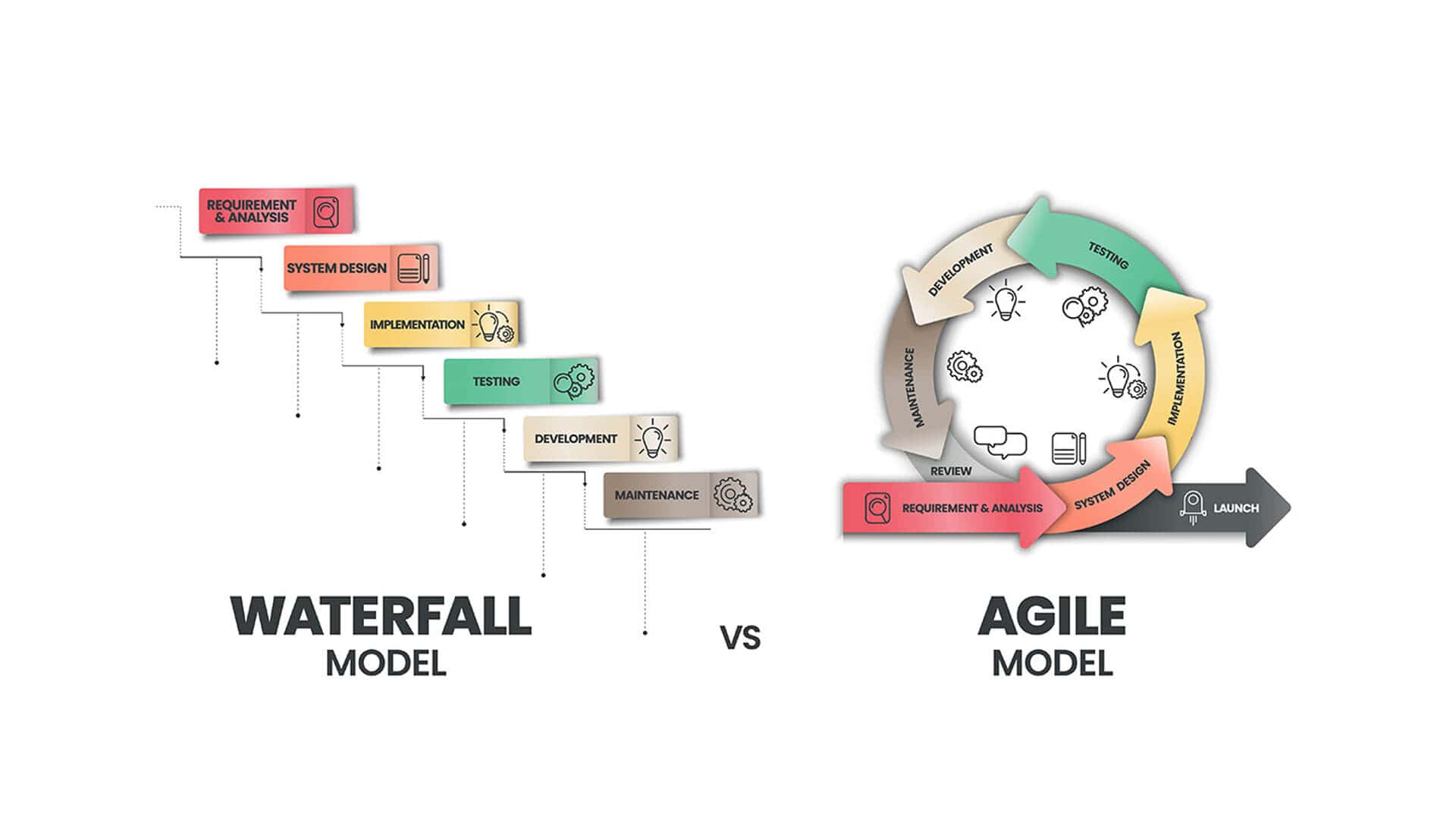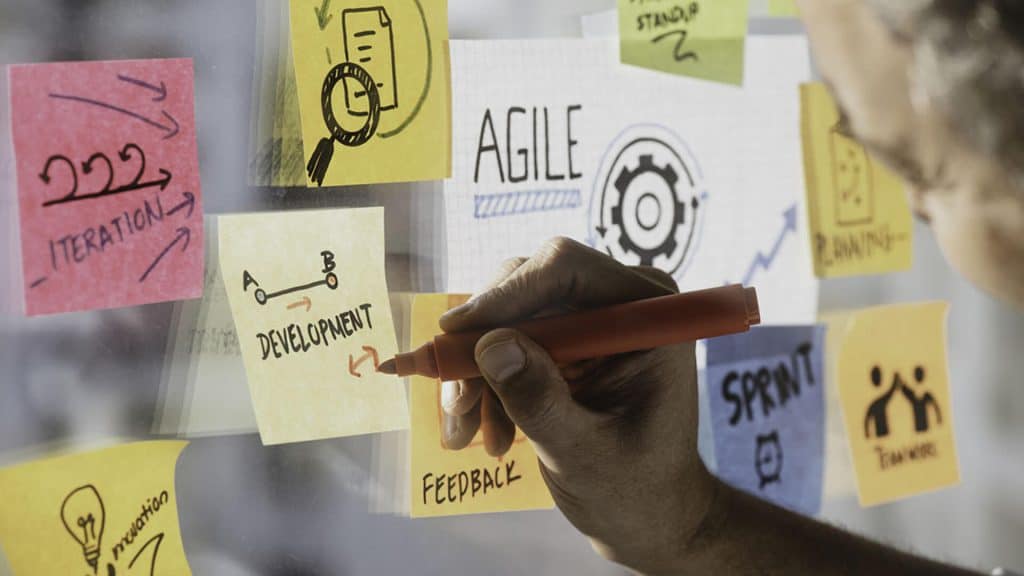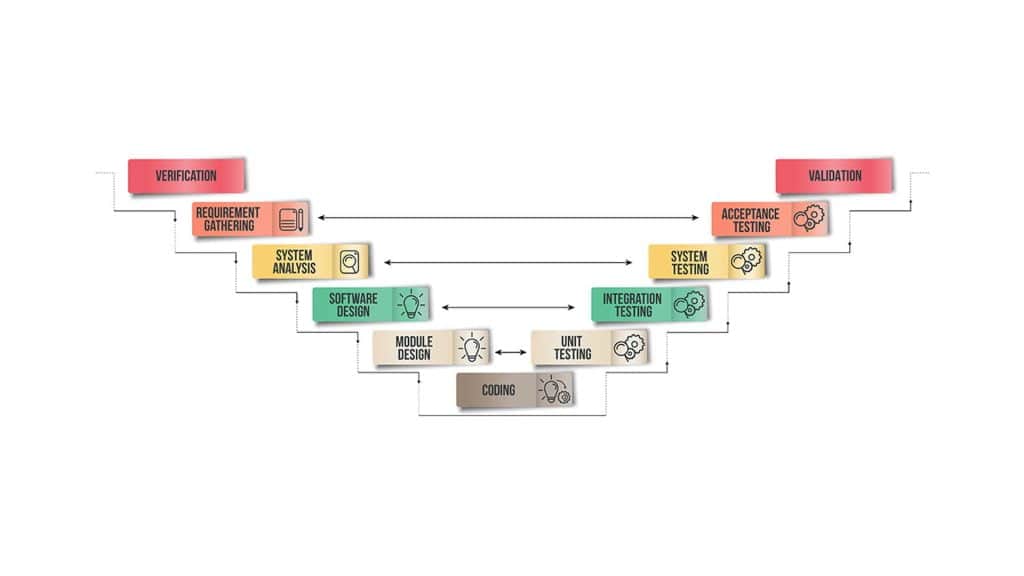1. Introduction to Waterfall and Agile Methodologies
Choosing the right software development methodology is essential for efficient and successful completion of your software development project. This article will help you understand which is right for you.
Agile and Waterfall are the most popular project management methodologies, each offering unique approaches and benefits in managing project development.
Agile software development deploys a flexible and iterative approach, using short iterations and an incremental delivery of valuable software.
Waterfall uses a rigid structure. It uses a fully documented, linear process with multiple stages where each stage has to be completed before the next can be started.
Each methodology aligns with different software development project needs and development teams dynamics.

2. Agile Methodology: A Flexible Approach to Project Management
Agile development process
Agile methodologies have their roots in an iterative and incremental approach to development and customer involvement, aligned with the Agile Manifesto [1]. Agile has become the preferred choice for software development projects that require adaptability and prompt delivery.
Agile projects are characterized by collaboration, customer feedback, and rapid delivery using short, iterative software development cycles. One variant, Scrum, uses short weekly sprints overseen by a Scrum master.
Extreme programming is another use of the agile framework by software projects, with sprints taking minutes, achieving continuous delivery.
The agile model promotes a customer-centric approach, ensuring that the development aligns closely with customer requirements and can easily adapt to changes.

Advantages
One of the most celebrated advantages of agile methodologies are their capability for Rapid Delivery. Using iterative cycles teams can deliver updated product versions in short timescales without the need for up-front comprehensive documentation.
A rapid release of the initial version soon followed by multiple iterations enables teams to continuously deliver value to customers. This software development lifecycle ensures that the product is developed and enhanced in alignment with user needs and market demands.
Another advantage is Customer Satisfaction. Agile places a significant emphasis on continual customer involvement throughout the development process. This ensures that the development team and project manager are fully aligned with the product expectations and any changing requirements.
Adaptability is also a hallmark of Agile methodology. Agile is inherently designed to accommodate changes, even late in the development process. This flexibility ensures that the project can pivot in response to changing customer needs, market dynamics, and technological advancements.
Disadvantages
Despite its numerous advantages, Agile also comes with its set of challenges. The flexible and adaptive nature of agile project management can lead to uncertainty with budgets and resource allocations, with Unclear Final Costs.
Dependence on Customers is another disadvantage of the incremental approach. Active customer participation is required throughout the development process. If this is absent, the lack of ongoing feedback and approval can harm alignment with customer expectations.
The adaptability of an agile approach is an asset, but can lead to Scope Creep. This can extend the project beyond its original scope, affecting timelines and resources.
3. Waterfall Methodology: A Structured Path to Project Completion
Waterfall project management methodology
One of the key differences of Waterfall is its use of a rigid, linear process. Projects managed under the waterfall model progress through predefined stages until the final stage is reached. Each stage requires full project requirements to be defined up-front by the project managers.
Typical development phases in waterfall projects include:
- Conception
- Initiation
- Analysis
- Design
- Construction
- Testing
- Deployment
- Maintenance
- Ongoing support
Each stage must be completed before moving to the next phase.

Advantages
The Clear Structure of Waterfall projects is often hailed as one of its primary advantages. The linear and sequential nature provides clearly defined milestones, a clear project timeline, and an easily understood project path.
This provides teams and product owners with a well-defined roadmap for the project. Stakeholders can gain a clear understanding of project progress and milestones.
One advantage of the Waterfall model are the Defined Deliverables at every stage. These provide clear direction and facilitate development team resource planning.
The structured nature of Waterfall provides Minimal Scope Creep. Any changes or additions to the project scope are thoroughly evaluated and approved before being implemented.
Disadvantages
This methodology is not without its disadvantages. The primary one is Inflexibility. Once a phase is completed, making changes can be complex and costly.
The linear progression towards working software means that any alterations require a significant backtrack. This impacts the timelines and costs of completion. This inflexibility can be particularly challenging in complex projects where requirements may evolve or where unforeseen changes occur during the project lifecycle.
The Late Testing Phase is another notable disadvantage of the Waterfall methodology. Testing is conducted after the build phase, which means that any issues or bugs are identified very late in the development cycle, leading to delays in completion and additional costs.
Lastly, the Waterfall methodology can result in Lengthy Project Timelines. The sequential process and the potential for rework can result in extended project durations.
The need to thoroughly complete each phase before progressing to the next also means that the project may take longer to deliver, particularly when compared to more iterative and parallel approaches like Agile.
4. Waterfall vs. Agile: A Comparative Analysis
When examining waterfall vs agile, the key differentiator lies in their approach to project development and management. The iterative development of an agile approach allows for changes and evolution throughout the project, while Waterfall’s structured approach resists any change to the initially defined requirements as the project progresses.
Differences, Advantages, and Disadvantages
Differences: An Agile method promotes iterative, customer-involved development, while Waterfall adheres to a strict, linear development process.
Advantages: Agile offers flexibility and customer satisfaction, whereas Waterfall provides clarity and a defined structure.
Disadvantages: Agile can lead to unclear final costs, while Waterfall struggles with inflexibility and late testing phases.
5. Real-World Applications: Waterfall vs Agile vs unveiling key differences and use cases
Use Cases for Agile
Tech Startups: Agile is widely adopted in tech startups where the product vision might evolve with ongoing customer feedback. The iterations allow the design to evolve and adapt to changing market demands.
Mobile App Development: Agile supports the rapid development and release cycles of mobile apps, enabling developers to iteratively update apps based on user feedback and technological advancements.
Marketing Campaigns: Agile enables marketing teams to adapt campaigns in real-time, adjusting strategies based on ongoing performance data and market trends.
Use Cases for Waterfall
Construction Projects: The waterfall approach is prevalent in construction projects where each phase has clear deliverables and a defined path, ensuring that the project adheres to architectural plans and regulatory compliance.
Manufacturing: Waterfall is suitable for manufacturing processes where product development moves through sequential stages, from concept to production, ensuring consistency and quality.
Government Projects: Often, government projects have well-defined requirements and regulatory constraints that align well with the structured approach of the waterfall methodology.
6. Making the Choice: Deciding Between Waterfall and Agile
Choosing between Waterfall and Agile methodologies hinges on various factors, including the project’s scope, team dynamics, customers, and risk management.
Project Scope and Requirements: Agile is suitable for projects with evolving requirements, while Waterfall is apt for projects with well-defined scopes.
Team Dynamics: Agile teams often require a higher degree of collaboration and self-management, whereas Waterfall teams may operate well with clear directives and structured phases.
Customer Involvement: Projects that benefit from ongoing customer feedback and iterations may prefer Agile, while those with set specifications and minimal customer interactions during development may opt for Waterfall.
Risk Management: Agile allows for ongoing adjustments and pivots, potentially reducing the risk of late-stage issues, while Waterfall might identify risks and issues during the testing phase.

7. Conclusion
Choosing between Waterfall vs Agile for your software development project requires a keen understanding of both methodologies, including their respective advantages, disadvantages, and use cases. While Agile offers flexibility and continuous improvement, Waterfall provides a structured and linear path for project development.
Manifesto for Agile Software Development (agilemanifesto.org) [1]

